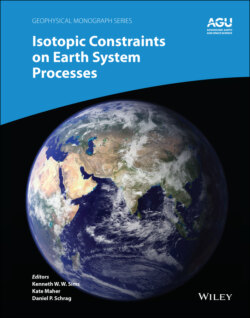Читать книгу Isotopic Constraints on Earth System Processes - Группа авторов - Страница 76
3.4.5. Origin of the Light Calcium Isotope Composition of Laacher See and other Intrusive Carbonatites
ОглавлениеThe distinctly light calcium isotope signature (δ44Ca = –0.39 ± 0.14‰ [2σ]) of the intrusive Laacher See carbonatite is the sole outlier in this study, and is distinct from what is found in most igneous samples (see compilations in Antonelli & Simon, 2020; Schiller et al., 2016). It is possible that the mass‐dependent calcium isotopic deficit seen in Laacher See carbonatite is an artifact produced by relatively large (~4 epsilon‐unit) radiogenic 40Ca effects, as can be seen in Precambrian samples (e.g., Antonelli et al., 2019c; Mills et al., 2018; Simon et al., 2009). This is unlikely given the fact that the carbonatite clast studied was cogenetic with its ~12.9 ka phonolite host, which exhibits negligible evidence for assimilation, and contained zircons that range from 32.6 ± 4.1 ka to near‐eruption in age (Schmitt et al., 2010).
The calcium isotope composition of the Laacher See carbonatite could originate from recycling of isotopically light marine carbonate as suggested recently for other carbonatites (Amsellem et al., 2020). This would involve carbonate subduction through a long deep convection cycle, which is required given the fact that the East Eifel Volcanic Field is in Central Europe, far from a modern subduction zone. Amsellem et al. (2020) recently reported light calcium isotope data for a large number of Ca‐, Mg‐, and Fe‐rich carbonatites spanning from ~3 Ga to ~1 Ma. Their findings are important because they may provide timing constraints for the onset of plate tectonics and subduction of marine sediments. Furthermore, their conclusions imply that since at least 3 Ga there has been relatively similar levels of marine biomineralization, seawater conditions, and continental weathering to produce isotopically light marine carbonate. This does not appear to be true, however, as over approximately the same timespan (~3.0 to 0.7 Ga) there is little evidence for isotopically light marine carbonate in the geologic record (Blatter & Higgins, 2017). In fact, the extensive Precambrian carbonate record reported by Blatter and Higgins (2017) is dominated by BSE calcium isotope compositions. This record poses a serious problem for the interpretations of Amsellem et al. (2020), which necessitate that ancient carbonatites form from recycled light marine carbonates.
The Laacher See carbonatite is notable, in part, because it is the youngest intrusive carbonatite example known on Earth. It may also be important that it is an intrusive rather than an extruded sample. Another significant characteristic of the Laacher See carbonatite is that its oxygen isotopic composition is similar to the relatively narrow range (δ18OSMOW = 5–8‰) exhibited by mantle‐derived mafic rocks (Schmitt et al. 2010; Taylor et al., 1967). In general, more silicic igneous rocks and most metamorphic and sedimentary rocks exhibit higher δ18O values. This similarity has been used to suggest a possible genetic relationship between the Laacher See carbonatites and rocks that are commonly believed to originate in the lower crust or upper mantle. Because oxygen is a major component of the studied materials, their oxygen isotopic composition has been used to argue that it is difficult for the Laacher See carbonatites to have formed by addition of any significant sedimentary carbonate component, which generally have much higher oxygen isotope compositions (δ18OSMOW = 15–25‰; Taylor et al., 1967). It follows, therefore, that its CO2, and perhaps calcium, is likely also primary and not due to marine carbonate recycling. Taylor et al. (1967) do point out, however, that the Laacher See carbonatites could form from assimilation of carbonate if these materials had undergone recrystallization and oxygen exchange with primary igneous rocks. It should also be noted that despite the fact that a large number of carbonatite complexes around the world do exhibit mantle‐like C and O isotopic signatures, some exhibit much heavier oxygen isotope compositions than the Laacher See carbonatites. These heavy oxygen isotope values are consistent with what might be produced by assimilation of sedimentary carbonate country rock (e.g., Santos and Clayton, 1995; Wei et al., 2020). Consequently, the relatively constant δ44Ca ~ –0.4 values seen in carbonatites, over the past 3 Ga, probably reflect a more universal mass‐fractionation process rather than the incorporation of a relatively constant amount (6–7%) of recycled marine carbonate sediment into their mantle sources (cf. Amsellem et al., 2020).
Laacher See carbonatite has had a protracted sub‐solidus history as an intrusive rock and has a calcium isotopic composition that is similar in magnitude and sign to the mass‐fractionation seen for carbonatite metasomatism (Ionov et al., 2019). Therefore, the most likely explanation for its calcium isotopic composition is that its formation included fluid alteration and/or a partially dehydrated source rock from which isotopically heavy Ca‐bearing fluids have been lost, analogous to that reported by John et al. (2012) for metasomatism in subduction zones. Given that a majority of carbonatites have a similar light calcium isotopic composition, and yet marine carbonates may not have had isotopically light calcium isotope compositions in the past, there is no simple scenario in which marine carbonate recycling is the dominant explanation for their calcium isotopic composition.
